 advertisements advertisements
|

|
Astronaut Jon McBride, early NASA space shuttle pilot, dies at 80
August 7, 2024 — Former NASA astronaut Jon McBride, who was the pilot on the first mission to launch seven people into space, has died at the age of 80.
McBride's death on Wednesday (Aug. 7) was confirmed by NASA after the agency heard from his family.
"Jon McBride dedicated himself to the nation we love. His leadership during one of the early space shuttle missions — as the pilot for the first crew of seven — expanded our possibilities in the stars. He was my friend, and we will miss him," said NASA Administrator Bill Nelson in a social media post.
A member of the "TFNG" ("Thirty-Five New Guys"), NASA's first group of space shuttle astronauts selected in 1978, McBride's first and only flight into space was as pilot of the space shuttle Challenger's sixth flight into space on Oct. 5, 1984.
"We lifted off, started accelerating, and it was just — wow," said McBride in a NASA oral history interview in 2012. "Simulators are good, but this is just something else, and you get up to 3Gs [three times the force of gravity] and then it's a whole different place in your life. Not that I hadn't had 3Gs before; I'd [just] never had them through my chest for three minutes."
McBride's six crewmates included STS-41G commander Bob Crippen, who three years earlier had been pilot on the first flight of the space shuttle program; mission specialists Kathy Sullivan, Sally Ride and David Leestma; and payload specialists Paul Scully-Power and Marc Garneau.
The eight-day mission was the first to fly two women (including Ride, who on a previous Challenger flight had become the first American woman in space). It was also the first to see a U.S. woman perform a spacewalk (Sullivan) and the first flights of Australian (Scully-Power) and Canadian (Garneau) crew members.
McBride and his crewmates deployed the Earth Radiation Budget Satellite (ERBS), which recorded the energy emitted by the Sun and how much bounced off Earth's atmosphere into space, and operated Shuttle Imaging Radar-B (SIR-B), which collected radar images our planet from several different angles.
McBride and his crew's activities were documented using a large-format 70mm camera and featured in the 1985 IMAX documentary "The Dream is Alive."
On Oct. 13, 1984, Crippen and McBride brought Challenger back to Earth, landing the space shuttle for only the second time at Kennedy Space Center in Florida.
"I'm not trying to diminish the entry and the landing, but if you can fly airplanes on and off of aircraft carriers and do all the things that we do and you follow the procedures, flying the space shuttle is pretty easy after a few thousand hours of practice in it and simulators and the shuttle training airplanes," said McBride. "Golly, it was nice to be back on Earth and have a perfect landing and rollout on time and everybody's happy. We did all of our mission objectives. But flying the space shuttle is probably one of the easier airplanes I've ever flown."
As one of the five first-time fliers on the mission, McBride logged 8 days, 5 hours, 23 minutes and 33 seconds in space while traveling 3.3 million miles (5.3 million kilometers) during 133 trips around the planet. He was the 156th person to fly into space and 149th to orbit Earth according to the Association of Space Explorers' Registry of Space Travelers.
Jon Andrew McBride was born on Aug. 14, 1943 in Charleston, West Virginia, but considered Beckley to be his hometown. He attended West Virginia University from 1960 to 1964 and received a Bachelor of Science in aeronautical engineering from the U.S. Naval Postgraduate School in 1971.
In 1965, McBride reported to Pensacola Naval Air Station in Florida for naval aviation training and, after earning his wings, was assigned as a naval aviator to Fighter Squadron 101 at Naval Air Station Oceana in Virginia. He was later assigned to Fighter Squadrons 41, 11 and 103, and flew 64 combat missions while deployed to Southeast Asia.
McBride then attended the U.S. Air Force Test Pilot School at Edwards Air Force Base, prior to reporting as a maintenance officer and Sidewinder project officer to Air Test and Development Squadron Four at Point Mugu, California. It was while serving in this position that McBride was selected by NASA for its astronaut corps.
"Six o'clock in the morning exactly, which would have been eight o'clock in Houston, I heard the phone ringing," said McBride. "I was barely awake when I picked up the phone."
The phone call was from George Abbey, then NASA's director of flight operations, informing McBride he had been chosen.
"Wow! I was awake now. I felt like I levitated about three feet off the bed," McBride recalled.
As of 1979, McBride had flown more than 40 different types of military and civilian aircraft and piloted the Navy "Spirit of '76" bicentennial-painted F-4J "Phantom in various air shows from 1976 to 1978. He logged more than 8,800 hours flying time, including 4,700 hours in jet aircraft.
Prior to his own spaceflight, McBride was the lead chase pilot for STS-1, the first flight of the space shuttle Columbia, in 1981.
"It was high overhead, 40,000 feet [12,200 meters], when John and Bob came out of orbit and made that first landing at Edwards, and we were joined up with them about 30,000 feet [9,150 m] or so. We were there primarily — they called us safety chase, but I think the best thing that came out of the whole rendezvous and fly-down was that we got some good photography," said McBride. "Our primary job was to scan the shuttle as it came out of orbit, because we'd never done it before, and if there's hydraulic leaks or missing parts of their control system, we could tell them. I don't know how much good it would have done, what they would have done, but, fortunately, there was no problem."
McBride also worked on certifying flight software in the Shuttle Avionics Integration Laboratory (SAIL) at NASA's Johnson Space Center in Houston, as well as served as capcom (capsule communicator) in Mission Control for STS-5, STS-6 and STS-7. He also managed the Flight Data File (FDF) and helped develop orbital rendezvous procedures.
After landing on STS-41G, McBride was named commander of STS-61E, leading a crew of six on a planned nine-day flight aboard Columbia. The astronomy-dedicated mission was targeted for launch on March 6, 1986, but was canceled in the wake of the loss of space shuttle Challenger and its STS-51L crew in January of that year. (The mission's ASTRO-1 payload was later flown on STS-35 in 1990.)
In July 1987, McBride was transferred to NASA Headquarters in Washington, D.C. to serve as Assistant Administrator for Congressional Relations. He held this position, overseeing NASA's communications with Congress, through March 1989, when he retired from NASA and the Navy (the latter with the rank of captain).
McBride was president and chief executive officer of Flying Eagle Corporation in Lewisburg, West Virginia and an executive associate for R.L. Bliss & Associates, Inc. in Charleston, before entering the race for Governor of West Virginia in 1996. He lost the Republican nomination to Cecil Underwood.
In 2005, McBride joined the management at the Kennedy Space Center Visitor Complex, overseeing the daily "Astronaut Encounter" and "Dine With an Astronaut" educational programs. McBride also advised on the landing sequence for the complex's $60 million "Shuttle Launch Experience" ride. He retired in 2020.
"We are deeply saddened by the passing of Captain Jon McBride, an American hero and veteran NASA astronaut," read a statement from the Kennedy Space Center Visitor Complex. "Jon inspired countless guests, crewmembers and people during his time working at the visitor complex and throughout his career."
For his service to the nation's space program, McBride was awarded the NASA Space Flight Medal and was bestowed with three honorary doctorates from West Virginia University (1985), the University of Charleston (1987) and West Virginia Institute of Technology (1987).
On Sept. 23, 2011, the NASA Independent Verification and Validation Facility (IV&V) in Fairmont, West Virginia named a NASA software laboratory the "Jon McBride Software Testing and Research Laboratory," or JSTAR. The lab supports end to end testing on mission flight software.
McBride was married to the former Brenda Lou Stewart in 1966 and they had three children. He and Brenda divorced in 1986. McBride then married the former Sharon Lynn White in 1988. He is preceded in death by his eldest son, Richard McBride; one of his eight grandchildren, Ryan; and one his STS-41G crewmate Sally Ride. |
|
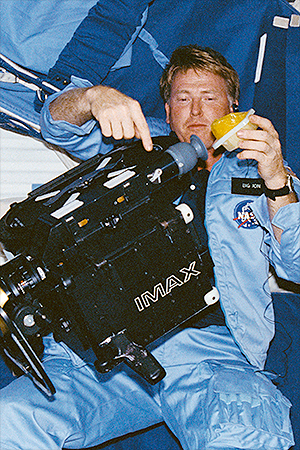
STS-41G pilot Jon McBride juggles working with an IMAX camera and holding onto an orange drink container aboard the middeck of the space shuttle Challenger in October 1984. (NASA)
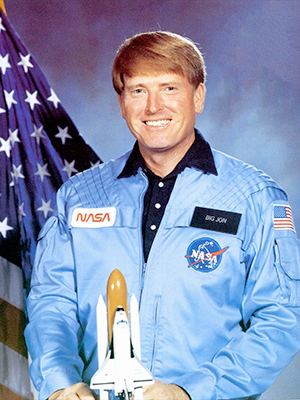
Official portrait of NASA astronaut Jon "Big Jon" McBride. (NASA)
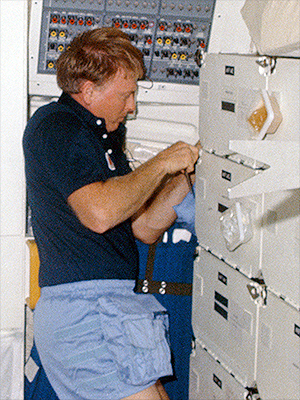
STS-41G pilot Jon McBride works at the middeck lockers on space shuttle Challenger as crewmates, commander Bob Crippen and mission specialist Kathy Sullivan look on, in October 1984. (NASA)
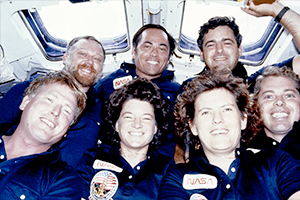
STS-41G pilot Jon McBride (at right) joins his six crew members for a photo on the space shuttle Challenger's flight deck: Paul Sculley-Power, Sally Ride, Bob Crippen, Kathy Sullivan, Marc Garneau and David Leestma. Thy were the first seven-person crew to fly. (NASA)
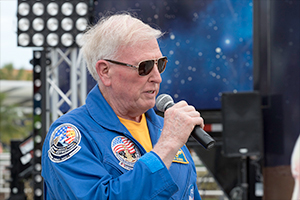
Director of Astronaut Education Programs Jon McBride speaks at the Kennedy Space Center Visitor Complex in Florida during a "Summer of Mars" promotion in June 2017. (NASA/Kim Shiflett) |
|

© 1999-2025 collectSPACE. All rights reserved.
|
|

|

|
